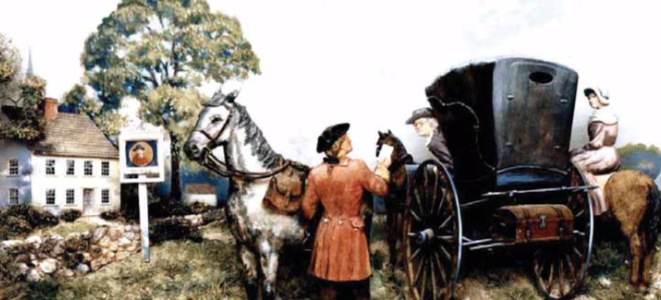
The Old Post Road
Part III, The Stagecoaches
See part 1 here.
See part 2 here.
By 1825, the business of travel by stagecoach was coming into full flower. A traveler could cover the distance from Boston to New York in a mere week, traveling in the relative comfort of a stagecoach and spending each night in one of an assortment of roadside taverns.
The stagecoaches of which we speak were generally made by the firm of Abbot and Dowling, of Concord, New Hampshire. Over the years, this firm turned out over three thousand of the stagecoaches, which we have seen featured on countless Western movies over the years.
For the stagecoach passenger, the day’s travel would start at three o’clock in the morning, when the stagecoach would leave Boston, and ride westward or southward out of town over darkened country roads. The passenger would not know who was sitting next to him until after first light. Such were the elements of romance and intrigue for early travelers of the Post Road. Perhaps one’s first morning sight from his stagecoach window in the predawn darkness was that of a farmer, lantern in hand, moving from house to barn to milk his cows.
All through the day, the stagecoach would travel the dusty Post Road, stopping but briefly for lunch at whatever tavern was handy. At last, long after dark, perhaps after ten o’clock, the stagecoach would stop for the night and for a simple meal, and then a fitful sleep on a too-short bed stuffed with corn husks, and then a morning that came much too soon, followed by another dusty, bouncing day down the Post Road.
At this time, there were three branches of the Post Road between Boston and New Haven: the Upper Route, which after leaving Boston passed through Worcester, Springfield and Hartford; the Middle Route, which passed through Thompson, Putnam and Pomfret before turning south at Hartford; the Lower Route more nearly approximated the course of today’s Route 1—it went through Providence, Mystic, New London and then onward to New Haven. The trip from Boston to New York at that time cost ten dollars, this in a time when a decent dinner could be had for less than a nickel.
The stagecoach’s rapid rise in popularity was later matched by its decline and demise wherever tracks were laid for the new railroads. Somewhere around 1840, the tracks were installed for the New York, New Haven and Hartford Railroad, and from that day the handwriting was on the wall. By the 1860s, the production of stagecoaches had ceased in New England. As passengers flocked to the smoother, faster rail transportation, the stagecoaches were shipped west, where they could now begin a second life. The Post Road had been largely displaced as a means of travel from New York to the cities of New England, and the evolution of the Post Road continued.